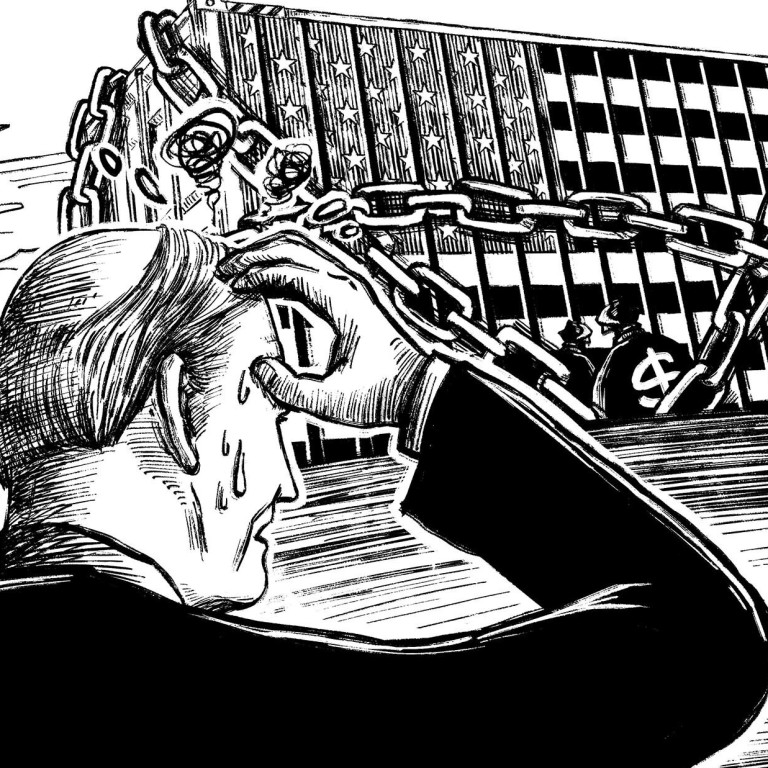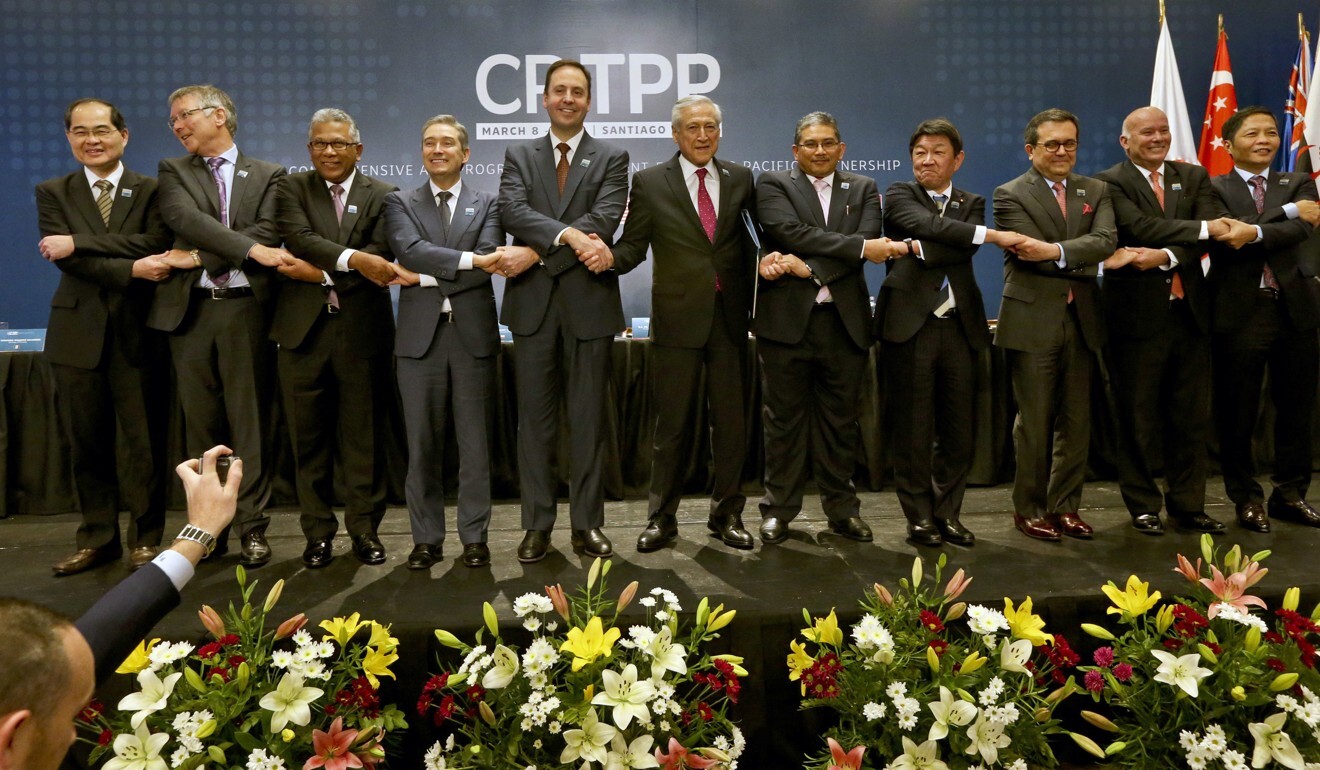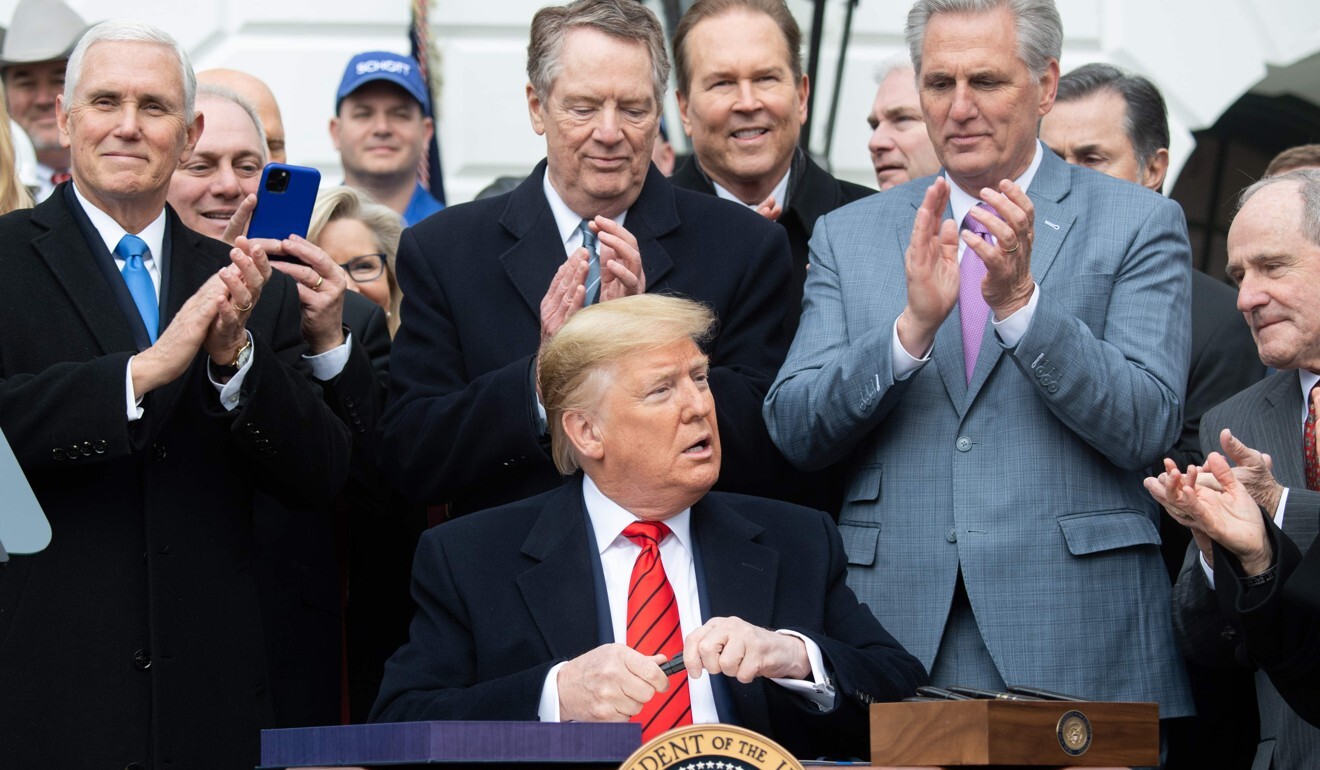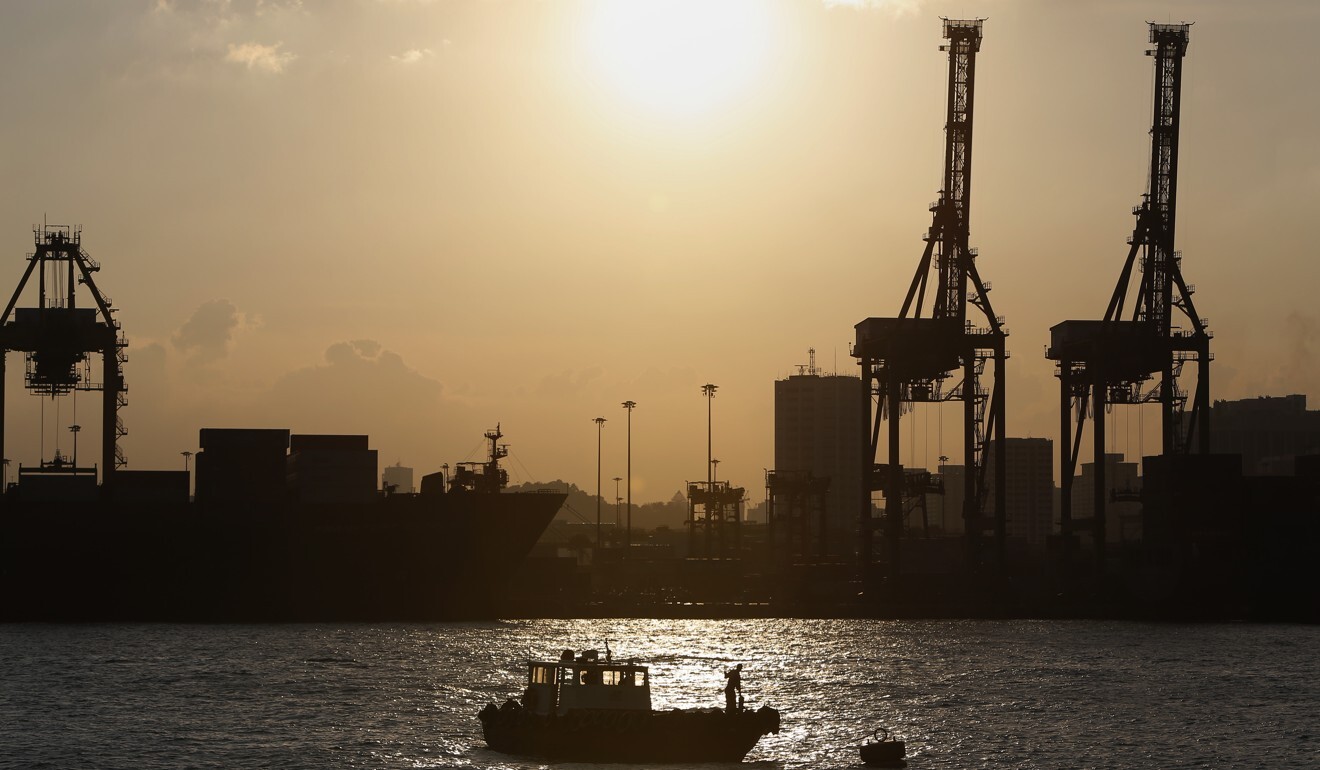
Could a win for Joe Biden see the US re-engaging on global trade?
- Donald Trump pulled America out of the Trans-Pacific Partnership, which aimed to promote free trade among 12 nations involved in 40 per cent of global business
- Analysts say a Biden administration might try to join the pact that replaced it to help boost US exports
As voters in the United States prepare for the presidential election in November, the South China Morning Post is exploring the potential ramifications for China. The latest part of the US election series looks at what a victory for Joe Biden could mean for US trade policy.
Four years of Donald Trump have shown the world how forcefully a single US administration can defy American foreign policy conventions.
For China and many of the other large economies of the Pacific Rim, one of the most significant of Trump’s norm-shattering behaviours on the international front was his first – taken on the second day of his tenure – when he pulled the United States out of the Trans-Pacific Partnership (TPP).
TPP was a proposed free-trade agreement among 12 Pacific nations – including the US as well as Southeast Asian nations like Malaysia, Singapore, Vietnam and Brunei – that aimed to ease or eliminate tariff and non-tariff barriers on goods and services, and would have established trade rules beyond World Trade Organization commitments.
While never billed as such officially, China’s exclusion from the TPP was a key attribute for the US and other countries looking to check the regional influence Beijing had been gaining in tandem with its economic growth.
With voter sentiment turning sharply against global trade in the run-up to the 2016 presidential election – one reason for then Democratic candidate Hillary Clinton’s loss that year – US participation in the new trading bloc was never assured. Trump’s open distain for TPP, or any multilateral trade agreement for that matter, meant that America’s pull-out surprised no one when he assumed office.

“I recall vividly hearing about President Trump’s decision to exit TPP,” said Wendy Cutler, the US Trade Representative office’s chief negotiator for the trade pact under Trump’s predecessor Barack Obama.
“My immediate thought was what a huge loss for the United States, which would have long-term effects on our position and perceived commitment to the region.”
The withdrawal left Japan, Canada, Mexico and seven other countries to pick up the pieces and reconstitute the trade agreement without the US, with the revised pact going into effect in December 2018.
These days, the TPP that was to account for about 40 per cent of global trade is instead the Comprehensive and Progressive Agreement for Trans-Pacific Partnership (CPTPP), which – despite its much larger name – covers a much smaller 13 per cent slice of global commerce.
With most polls suggesting a decisive win for his Democratic opponent Joe Biden in the popular vote, the likelihood increases that his drive to curb America’s engagement with multilateral institutions and agreements will end.

According to former trade officials from both political parties, attitudes towards global trade have evolved in the US since 2016, not only among voters but also lawmakers of both US political parties, making the environment for re-engagement overtures by Washington safer, particularly if Biden wins the White House next month.
A leading cause of trade policy concern, they say, is that – large grain purchases aside – Trump’s tariff war with China has failed so far.
According to the final monthly trade figures released by Beijing before the US presidential election, China’s trade surplus with the United States was 43.6 per cent larger last month compared with January 2017.
US election: what would Trump and Biden foreign policy teams look like?
“We lost a lot in terms of economics by pulling out” of TPP, said Carla Hills, US trade representative under Republican president George H W Bush.
“We now have a situation where the Asean [Association of Southeast Asian Nations] group have open trade with Japan. The EU has open trade with Japan. I mean just on a competitive basis, the diversion of trade from our producers is quite substantial. So of course I would argue let’s get back in.”
The concern that by turning away from the TPP, the US gave up more than it gained was echoed in a US Congressional Research Service (CRS) report published about a year after the withdrawal.

Highlighting the trade talks that Hills referred to, the non-partisan CRS said: “To the extent these agreements take a different approach on issues such as the level of liberalisation, intellectual property rights, labour and environment commitments, and new rules like state-owned enterprises and e-commerce, they could result in provisions favouring the parties involved and not the United States.”
Even Chuck Grassley, an Iowa Republican who is chairman of the Senate Finance Committee, told Axios last year that it “was a mistake” to withdraw from TPP, and that a trade deal with Japan might “make up 90 per cent of the bad things that resulted because we pulled out” of the trade bloc.
Negative views of China and Xi Jinping at record levels
“The list of top issues for voters include the economic downturn, Covid-19, health care generally, racial justice, terrorism, education and now the Supreme Court nomination, while trade and China have fallen further down the priority list for most Americans,” said Eric Altbach, a deputy assistant US Trade Representative for China affairs in the Obama administration.

06:04
US-China relations: Joe Biden would approach China with more ‘regularity and normality’
“Regardless of who wins the US presidential election, both parties are going to have grapple with trade policy in a more serious way,” said Altbach, now a senior vice-president at Washington-based consultancy Albright Stonebridge Group.
“The Trump administration’s decision to pull out of TPP and pursue a trade policy that can only be described as unilateral, protectionist and ultimately incoherent, has not delivered the domestic economic benefits or the concessions from our trading partners that was promised.”
The report also showed similarly negative views of China among respondents in the CPTPP nations Canada, Japan and Australia.

Trump’s vision of a “Fortress America”, where US manufacturers produce everything they need domestically, is unrealistic, said Mary Lovely, a senior fellow at the Washington-based Peterson Institute for International Economics.
“The Trumpers have this idea that we‘re going to bring supply chains back home, and that is not going to happen, so where are we going?”
Trump taunts Biden over ‘George’ stumble
Many Americans “don’t want to deal with a communist country that they don’t understand, with human rights positions they don’t approve of, to put it mildly”, she said.
“So if we want to reduce our dependence on China, the only other game in town, besides the USMCA, is CPTPP.”
The United States-Mexico-Canada Agreement, essentially a revised and more labour-friendly version of the North American Free Trade Agreement (Nafta), is cited frequently in a report Cutler published last month, in her capacity as managing director of the Asia Society Policy Institute’s Washington office.
The report, “Re-engaging the Asia-Pacific on Trade: A TPP Roadmap for the Next US Administration”, said the USMCA, which eventually received bipartisan support, “borrowed heavily from the TPP”.
Cutler highlighted the estimate, by Bruce Heyman, a former US ambassador to Canada, that two-thirds of the USMCA borrowed language directly from the TPP; a separate study found that “Nafta 2.0” copied 57 per cent of its text.
The primary new features written into the updated Nafta that paved the way for its bipartisan support were pro-labour provisions including a “rapid response mechanism to provide for an independent panel investigation of denial of certain labour rights … as opposed to a government inspection”, according to an analysis by the CRS in January.
US appeals against China’s WTO trade war tariff victory
The AFL-CIO – America’s largest coalition of unions – supported the USMCA. However, some labour unions, including the International Association of Machinists and Aerospace Workers, opposed the revised pact, with its president Robert Martinez Jnr announcing after its passage that USMCA did not do enough to stop the outsourcing of hundreds of thousands of jobs to Mexico.
“We are not aware of provisions in the newly negotiated agreement that effectively address this matter, especially when it comes to aerospace and other manufacturing sectors,” Martinez said in December.

Analysts said a Biden administration would need to get those labour rules written into the CPTPP framework if he decided to make entry a priority. Otherwise, the bid would be unlikely to win support from Congress, which would need to approve the deal, or from the broader American public.
They also cautioned that Biden, if elected, would need to spend the first part of his presidency – possibly the first year or two – trying to limit the economic damage that Covid-19 has caused in the US, and that it would be difficult to sell a free-trade deal as part of that effort.
But with tariffs having failed so far to address America’s trade deficit with China, a negotiated entry into CPTPP may emerge as a better way to boost exports, Lovely said – particularly because Asia’s economies are projected to recover more quickly from the pandemic.
The International Monetary Fund’s most recent economic projections see “emerging and developing Asia” as a whole growing 8 per cent next year, and Asean states at 6.2 per cent growth, compared to 3.1 per cent in the US.

“I never would have used the deficit as any kind of a welfare measurement, but [Trump and his advisers] have and China’s share of world exports hasn’t budged, so they haven’t succeeded,” Lovely said, adding that more Republicans were seeing that.
“With US unemployment rates so high I wouldn’t try [re-entering negotiations with CPTPP] right now,” she said. “If the economy improves, it’ll be easier to say ‘hey, maybe we should engage in trade right now’”.
Cutler’s road map back to what was the TPP acknowledges that the path will not be quick or easy, recommending steps that include the need to “make the case for trade” and easing into CPTPP with “limited, sector-specific” trade deals with its members.
TPP “was by no means perfect”, she said. “I am sure that our TPP partners would have been open to discussing targeted revisions, but that option was abruptly taken off the table.”











